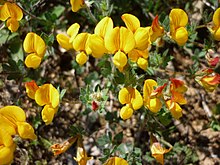| Lotus | |
|---|---|

| |
| bird's-foot trefoil Lotus corniculatus | |
| Scientific classification | |
| Kingdom: | Plantae |
| Clade: | Tracheophytes |
| Clade: | Angiosperms |
| Clade: | Eudicots |
| Clade: | Rosids |
| Order: | Fabales |
| Family: | Fabaceae |
| Subfamily: | Faboideae |
| Clade: | Robinioids |
| Tribe: | Loteae |
| Genus: | Lotus L. |
| Type species | |
| Lotus corniculatus L.
| |
| Species | |
|
Between 70–150; see text | |
| Synonyms[1] | |
|
List
| |
Lotus, a latinization of Greek lōtos (λωτός),[2] is a genus of flowering plants that includes most bird's-foot trefoils (also known as bacon-and-eggs[3]) and deervetches[4] and contains many dozens of species distributed in the eastern hemisphere, including Africa, Europe, western, southern, and eastern Asia, and Australia and New Guinea.[1] Depending on the taxonomic authority, roughly between 70 and 150 are accepted. Lotus is a genus of legumes and its members are adapted to a wide range of habitats, from coastal environments to high elevations.
The genus Lotus is currently undergoing extensive taxonomic revision. Species native to the Americas have been moved into other genera, such as Acmispon and Hosackia, as in the second edition of The Jepson Manual.
The aquatic plant commonly known as the Indian or sacred lotus is Nelumbo nucifera, a species not closely related to Lotus.